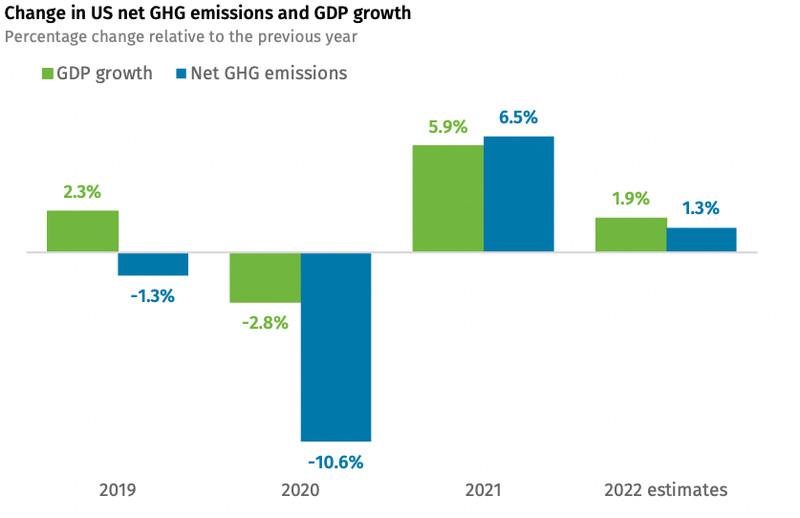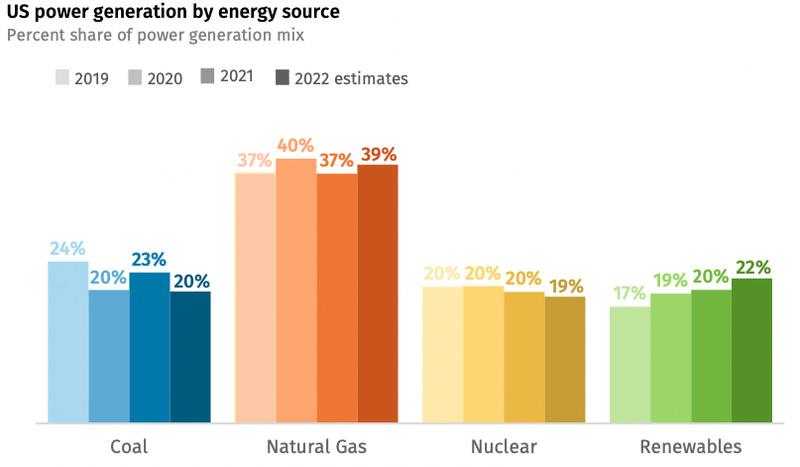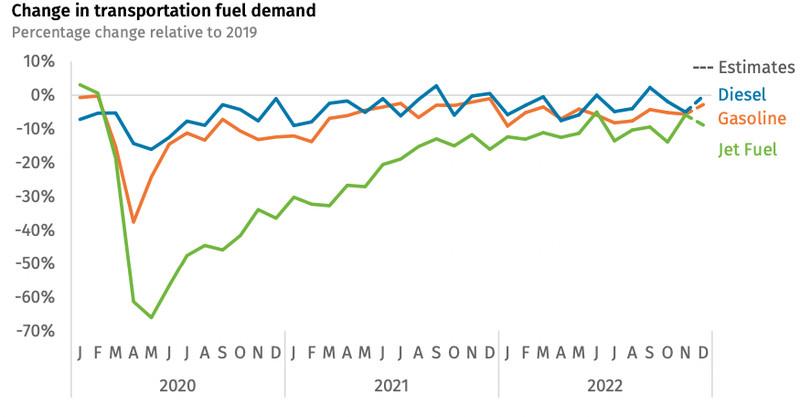
Economic growth outpaced the increase in carbon dioxide pollution.
Russia’s invasion of Ukraine, the ensuing global energy crisis, rampant inflation, and pent-up travel demand converged to nudge US greenhouse gas emissions upward again in 2022, according to a new analysis from the Rhodium Group research firm. This puts the US further off track from its climate goals, but the country now has a new suite of policy tools to curb emissions.
Emissions rose 1.3 percent compared to 2021, marking the second year in a row of growth, but the rate of increase has slowed down. Overall carbon dioxide output is also still below 2019 levels, prior to the Covid-19 pandemic. Renewables now comprise a larger share of power generation than coal. And transportation — planes, trains, and automobiles — was again the largest climate-polluting sector.
There are a couple of ways to read this. On the one hand, it’s troubling that emissions are rising in a year filled with relentless reminders of what can happen as average temperatures continue to climb. For the US, time is running out to meet its change targets. In 2021, President Joe Biden committed to cutting US greenhouse gas emissions in half relative to 2005 levels by 2030, just seven year away.
But on the other hand, while emissions rose last year, the economy grew by an even larger margin. One estimate reports that the US gross domestic product increased by 1.9 percent in 2022 compared to 2021. US GDP is now well above where it was prior to the pandemic. This decoupling of greenhouse gas emissions from economic growth shows that a country can prosper without having to increase its consumption of fossil fuels. More than 30 countries, including the US, have managed to decouple their economies from their emissions in recent years, and 2022 continued this trend.

Rhodium Group
The US, the world’s largest historical greenhouse gas emitter, could still do more to bend the curve. Though clean technologies are improving and getting cheaper, the US will still need stronger policies to meet its climate targets.
What’s driving up US greenhouse gas emissions?
While 2022 was a tumultuous year, the shocks weren’t enough to halt the inertia of the US energy sector. Coal, the dirtiest source of energy, is in a long-term decline while renewable energy sources like wind and solar power are better and more cost-effective than ever. Last year, renewables overtook coal, providing 22 percent of US power generation compared to coal’s 20 percent.
Natural gas demand also increased last year despite higher prices, but its share was still smaller than it was in 2019.

Rhodium Group
With pandemic restrictions relaxing, transportation demand increased in 2022, and with it, the demand for fuel. “The biggest thing we saw was people getting back on planes all year long,” said Ben King, an associate director at Rhodium Group who co-authored the emissions analysis.
The surge in fuel prices, however, tempered some of this growth.

Rhodium Group
Americans also drove more. Electric vehicle sales continued to set new records. Automakers sold more than 800,000 EVs in the US in 2022, adding up to 5.8 percent of all vehicles sold in the country, compared to 3.2 percent in 2021. However, gasoline and diesel still dominate the roads, and the American desire for larger cars has offset much of the improvement in efficiency. SUVs consume about 20 percent more energy than midsize cars.
This year, the US has some new opportunities to cut its greenhouse gas emissions. With the Inflation Reduction Act going into effect, the US will have $369 billion to pursue cleaner energy. It’s the largest single climate change investment in US history, funding battery plants, solar panels, and tax credits for EVs. All this stands to accelerate decarbonization and reduce emissions. “I think things like the Inflation Reduction Act can help juice that a little bit,” King said.
However, with the House now under Republican control, the White House will have a harder time getting its climate agenda through Congress, leaving executive action, agency regulations, and states as the biggest levers of US climate policy. For instance, the Environmental Protection Agency is proposing new rules to cut pollution from power plants. States like California and New York are planning to end the sales of fossil fuel-powered cars entirely by 2035, sending a signal to automakers to build more electric cars and chargers. And on Tuesday, the Biden administration published a national blueprint for decarbonizing transportation.
It’s still possible, then, to reduce US greenhouse gas emissions this year. But it will take deliberate action to ensure the country stays on track.
----------------------------------------
By: Umair Irfan
Title: Why US greenhouse gas emissions rose last year
Sourced From: www.vox.com/science-and-health/23547051/greenhouse-gas-emissions-2022-increase-inflation-gas-price-climate-change-gdp
Published Date: Tue, 10 Jan 2023 19:00:00 +0000
Did you miss our previous article...
https://consumernewsnetwork.com/politics-us/americas-abortion-access-divide-has-been-reshaped-by-bluestate-border-communities






